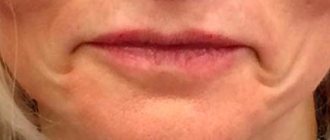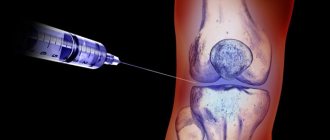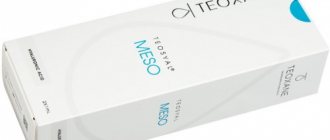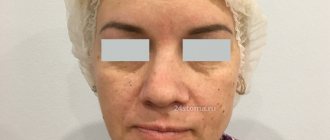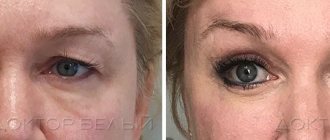Today, the role of a cosmetologist is more important than ever: stress, unbalanced and often excessive nutrition during several months of self-isolation, as well as physical inactivity have not had the best effect on the figures of many of our patients, leaving an unattractive mark, in particular, on the buttocks and thighs. A decrease in vascular muscle tone with subsequent stagnation of local hemostasis causes chronic hypoxia of adipose tissue [1], which leads to the formation of stagnant cellulite (gynoid lipodystrophy), skin atony, the appearance of local fat deposits, and sometimes stretch marks in the buttock area. Due to stagnation of lymph, skin color also suffers, its tone becomes uneven (Fig. 1).
RICE. 1. Change in skin tone due to chronic lymphatic congestion in the hip area.
The Internet is replete with buttock contouring techniques, and many patients and cosmetologists take them as a panacea. However, the first step to creating a beautiful figure, which is most justified from a physiological point of view, is the normalization of lymph and blood circulation.
Description of the procedure for buttock augmentation with hyaluronic acid
Hyaluronic acid is a substance found in small quantities in the human body. It is responsible for water balance and skin hydration. With age, its quantity decreases, the epidermis gradually dries out.
Products with hyaluronic acid, which are independently removed from the body, have replaced non-absorbable implants. They are usually used to get rid of wrinkles and restore youthful skin to the skin, but can also be used for body contouring. In addition to increasing volume, such substances improve collagen production, and the skin becomes smooth and tightened.
The higher the acid concentration in the product, the more fluid it retains, so gels for injection into the buttocks are much denser than products for the face.
Advantages and disadvantages
Buttock augmentation with hyaluronic acid has gained great popularity due to its many advantages:
- Hyaluronic acid not only gives volume and beautiful shape to the buttocks, but also has a beneficial effect on the condition of the skin: it fills the cells with moisture, smoothes it and restores its elasticity.
- The procedure is not a surgical procedure. Thanks to this, you can get by with minimal preliminary preparation, and the rehabilitation period takes little time.
- Fillers leave no scars.
- Hyaluronic acid is present in the human body, and therefore the risk of allergies is extremely low.
- The drug is created from natural, not artificial, substances, and is not rejected by the body.
- Fillers with hyaluronic acid are cheaper than implants or products made from artificial components.
- Natural appearance of the buttocks after the procedure.
Despite the obvious advantages, there are some pitfalls:
- If you want to add noticeable volume to your figure, fillers with hyaluronic acid are not helpful here; they only improve the shape of the buttocks and slightly enlarge them.
- The drug itself was created relatively recently, its effect on the body in the long term has been poorly studied.
- Sometimes the filler changes its location, for example, it slips, the buttocks seem to droop. To fix this, you have to resort to surgery.
- The body begins to break down the injected gel after six months. To maintain shape, periodic adjustments are required.
- The filler will completely dissolve in a year and a half, and the figure will return to its previous shape.
STAGES OF ENDOPROSTHETICS OF THE BUTTOCKS
Let's look at each stage of the surgical procedure.
Gluteoplasty is performed under general anesthesia. In our practice, we try to administer exactly the volume of potent painkillers that is necessary in a particular case, and not to exceed this volume. For this reason, we consider it best to limit ourselves to epidural anesthesia if an isolated operation is planned (not supplemented by lipofilling and liposuction). Sometimes it is necessary for the catheter to remain in the epidural space and pain relief to continue for up to 48 hours after surgery.
For buttock replacement surgery, we use special medical instruments, such as a retractor (an expander that allows for increased flexibility of manipulation). With its help, we are able to create a “bed” (pocket) for the prosthesis as accurately and correctly as possible.
Rice. 11. Medical instruments included in the main kit for gluteoplasty. From left to right the following instruments are located: hooks, a dilator (retractor) with two “blades”, an electric knife and coagulation tweezers. In some cases, there is a need for a hook with an illuminator - a device that solves the problem of insufficiently good visualization of the wound.
After marking is completed, we proceed to fitting the sizer (temporary endoprosthesis). The result of such a fitting in this particular situation is the choice of a round implant with a volume of 275 ml, medium plus projection. Such a prosthesis will fit well into the boundaries of the gluteus maximus muscle and will not go beyond them.
Rice. 12. Trying on a sizer
You have the opportunity to see each stage of the surgical procedure in detail, since we used two photographic angles: from above and from the side.
So, let's proceed to infiltration - a procedure that will allow us to significantly reduce bleeding during the subsequent separation of the subcutaneous layer in the anatomical area above the fascia of the gluteus maximus muscle. We inject saline solution with adrenaline into the area limited by the marking lines forming an “inverted” heart.
Rice. 13. Infiltration of soft tissues Next, we make a skin incision, leaving stripes resembling a spindle in shape.
Rice.
14. Skin incision for implant installation The next phase of the operation is subcutaneous dissection (detachment) in the anatomical area above the fascia of the gluteus maximus muscle. The lines delimiting the “inverted” heart will help us maintain the accuracy of the manipulations. The incision is made using a special electric knife, which makes it possible to avoid bleeding during detachment.
Rice. 15. Subcutaneous detachment and soft tissue incision
We present to you a photo of subcutaneous dissection in an enlarged form, obtained using the zoom mode. The use of a retractor with an illuminator ensured image clarity. You can clearly see the whitish fascia that covers the gluteus maximus muscle.
Rice. 17. Completion of detachment
The photo shows that the fascia that covers the gluteus maximus muscle is crossed by a marking line. The cut along this line should be made in such a way that the instrument is positioned in an oblique direction (approximately half a right angle) - in this case, the muscle will be dissected along its fibers.
Rice. 18. Cut along the marking line
Next, using the tip of the index finger (the length of its phalanx is about 2 cm), in the so-called blunt way, we push the muscle fibers apart to a depth of about 2 cm. At the same time, we remember that the gluteus maximus muscle has a thickness of 4 to 5 cm.
Rice. 19. Spreading the fibers of the buttock muscles.
The following photo shows the fibers of the gluteus maximus muscle found above and below the dilator. Thus, a “pocket” (bed) for the endoprosthesis is formed in the thickness of this muscle. When creating a bed, the specialist holds the outer limits of the muscle separation under control with his left hand.
Rice.
20. Fibers of the gluteus maximus muscle found above and below the expander In some cases, when performing gluteoplasty, it becomes necessary to use another medical instrument - a spreader, which has blunt rounded lateral edges and resembles a sickle. Such an instrument helps the surgeon not only achieve extreme accuracy when forming a “pocket,” but also measure the size of the latter. To do this, you need to connect both halves (branches) of the raspator together.
Rice. 21. Using a steamer.
Rice.
22. Distance between the ends of the jaws of the instrument Now, in order to form such a “pocket”, which is necessary for the prosthesis we have chosen, we just need to separate the halves of the raspator placed in the intermuscular area in different directions. It is important not to forget that we need to create a bed that will be slightly wider than the “base” of the implant. This measure will prevent deformation of the endoprosthesis and excessive pressure on it from the muscle. This precaution plays an important role specifically with the intermuscular method of installing the implant, but it is not required when the prosthesis is located under the fascia.
Rice. 23. Forming a pocket.
For preventive purposes, the patient is given an injection (1g of antibiotic) intramuscularly. Then a temporary prosthesis is placed in the bed, pre-lubricated with a special gel to increase its glide. Using a sizer, we check whether the dimensions of the “pocket” we have created correspond to the parameters of the future endoprosthesis.
Rice.
24. Intramuscular injection of an antibiotic Next, we install a temporary implant in the bed. Straighten and evenly place the inserted sizer (its volume is 275 ml). We also know such data as the projection of the temporary prosthesis and its width, which allows us to conclude that it is advisable to install a round gluteal implant, the volume of which (300 ml) will slightly exceed the volume of the sizer.
Rice. 25. Installation of a temporary implant.
The specialist removes the temporary prosthesis from the bed. He carries out further manipulations wearing non-talc gloves.
The operating room nurse gives the surgeon the implant of the required volume. The prosthesis is in a sterile container. After removing the implant from it, the parameters of the latter must be checked. Then the product is treated with a special solution containing Betadine, an antiseptic. The above measures are extremely important, as they are prescribed by prosthetic manufacturers and help reduce the risk of postoperative complications.
To prevent blood from accumulating in the “pocket” and forming hematomas, we install an active drainage system consisting of tubes connected to each other and having a large number of holes at the end. Next, we insert the endoprosthesis into the bed and make sure that it is placed correctly and freely.
Rice. 26. Installation of a silicone implant
We bring the drainage to the skin in the area of the projection of the anus and fix the drainage to the skin.
Rice.
27. Bringing the drainage out The next step is to apply sutures that will connect the edges of the bifurcated muscle. The photo clearly shows that the prosthesis is completely hidden by a layer of the gluteus maximus muscle. The edges of the muscle are stitched so tightly that the prosthesis in the bed is hermetically “locked”, reliably isolated from the subcutaneous fat.
Rice.
28. Applying sutures connecting the edges of the muscle You have the opportunity to compare the appearance of the buttocks with the original after implantation of a round endoprosthesis with a volume of 300 ml. Then the process of suturing the subcutaneous fat layer occurs after placement of the prosthesis.
Rice. 29. Installation of the prosthesis and suturing of the subcutaneous fat layer
After the implants are installed in the “pockets”, it is necessary to make sure that the buttocks are absolutely symmetrical. You can evaluate the appearance (see Fig. 29) that the buttocks acquired after the installation of endoprostheses (before suturing).
Rice. 30. Final appearance of the buttocks before suturing
Next, the subcutaneous tissue is sutured using an absorbable thread.
Rice.
31. Stitching the wound The following photo shows the stage of fixing the edges of the wound to the de-epidermalized area of skin in the sacral area. The surgeon places separate interrupted sutures resembling the letter P. He leaves special rubber sutures in the subcutaneous fat layer.
Rice. 32. Fixation of wound edges and suturing
Rice. 33. Result of gluteoplasty immediately after surgery
The final stage involves applying fixing tapes to the operated area in order to eliminate tension in the suture area.
Rice. 34. View of the operated area after applying aseptic dressings and fixing tapes designed to eliminate tension in the suture area.
After 48 hours there is no longer a need for drainage. Swelling is observed in the areas that have undergone liposuction (waist, sides), as well as in the buttocks area.
Rice. 35. Appearance of the buttocks 48 hours after surgery (the patient is in a lying and standing position)
The recovery period passed quickly, without complications or pain, since from the first days after endoprosthetics of the buttocks the patient underwent rehabilitation procedures: magnetic therapy, light therapy (Bioptron) and microcurrent lymphatic drainage using homeopathic cocktails. On the 8th day, the sutures were removed, and the wound healed by primary intention.
Contraindications for use
You will have to abandon this method of buttock enlargement or postpone it for a while in the following cases:
- pregnancy and lactation;
- menstruation;
- intolerance to the components of the procedure;
- benign or malignant tumors;
- bleeding disorders due to illness or medication;
- chronic diseases in the acute stage;
- infections;
- inflammation or damage to the skin at the treatment site.
How to prepare
Those wishing to enlarge their buttocks using fillers should visit a doctor before the procedure. The specialist will make sure there are no contraindications and take urine and blood tests. Screening for sexually transmitted diseases is also carried out.
If there are no contraindications, the patient tells what effect he wants to achieve, and the doctor determines the required dose of the drug.
14 days before the procedure, the patient is prohibited from:
- drinking alcohol;
- take medications from the group of anticoagulants;
- strictly limit yourself in nutrition (the diet should be as varied and nutritious as possible);
- sunbathe and visit the solarium.
Technique of the procedure
The procedure is performed not by a cosmetologist, but in a sterile operating room. It is usually performed using local anesthesia, but people with a low pain threshold may need general anesthesia.
The doctor marks the places on the patient’s body where the drug will be injected and treats the skin with an antiseptic. Then incisions are made, small but deep, reaching the gluteal muscles. Cannulas are inserted into them, through which the gel enters the body. The doctor distributes the drug in the designated areas, giving the figure the desired shape. After the operation, the incisions are closed with cosmetic sutures, which are removed after 10 days.
The administration of the gel takes about an hour, and the doctor observes the patient for the same amount of time. The effect of the procedure is noticeable almost immediately, since the product dissolves under the influence of enzymes. Sometimes this does not happen and an additional dose of the drug is required.
Recovery period
After the procedure, the body needs about two weeks to recover. During this time, swelling will subside and lumps will dissolve. Patients may feel a nagging pain. If it is severe, doctors recommend taking painkillers.
To make rehabilitation as effective as possible, you should follow simple rules:
- stop playing sports;
- protect the buttocks from mechanical influences;
- do not go to baths, swimming pools, solariums;
- do not drink alcohol or smoke;
- Wear compression garments for a month to reduce pain and speed up the removal of swelling.
METHODS OF INSTALLING BUTT IMPLANTS AND THEIR VARIETIES
Today there are four known methods for installing endoprostheses, namely subcutaneous, subfascial, axillary and intermuscular.
Subcutaneous method of implant placement
The technique of subcutaneous installation of a prosthesis was first presented in 1973 in a scientific article by surgeons W. Cocke and G. Ricketson, who, using this method, managed to eliminate supratrochanteric fossae (recessions on the lateral outer surface of the buttocks) in the patient. The use of this technique leads to pronounced contouring of the implant, so today this method is no longer used.
Subfascial method of implant placement
The technique, which involves installing a prosthesis under the fascia of the gluteus maximus muscle, is not suitable for all patients. Important criteria that an applicant for surgery must meet are young age, good physical shape, absence of prolapse of the soft tissues of the buttocks and a large projection of the gluteal region. In addition, to avoid contouring of the prosthesis, it is necessary to ensure that the subcutaneous fat layer of the patient’s buttocks is thick enough.
Superficial gluteal fascia
The superficial fascia covering the gluteus maximus muscle is a sheet of connective tissue. In the area of the sacrum, as well as in the area of the iliac crest and the lower part of the buttocks, it is characterized by its maximum thickness. The superficial fascia has its minimum thickness in the center of the gluteal region. Therefore, the endoprosthesis should be positioned so that its lower third is under the lower part of the fascia. Surgical intervention performed in this way is considered more complex than subcutaneous implantation, since it involves precise (precise) formation of a bed for the prosthesis under the fascia. However, it is not always possible to avoid contouring when using the subfascial method (especially if the fat layer is small).
Submuscular method of implant placement
The technique of axillary gluteoplasty was first described by Jose Robles in 1984. This method is advisable to use in cases where the patient is satisfied with the volume of his own buttocks in their lower part, and it is necessary to increase the volume of the buttocks only in their upper part by installing a small implant. The disadvantages of the technique include the likelihood of the prosthesis moving downwards, as well as the risk of compression or damage to the sciatic nerve. In addition, it cannot be excluded that as a result of the operation, a disproportion in the gluteal region will arise: a lack of volume will form in the lower part of the buttocks and an excess of it in the upper part of the buttocks.
Intermuscular method of implant placement
The authorship of the technique belongs to R. Gonzales, who described it for the first time in 1992. The method involves ensuring reliable fixation of the endoprosthesis by surrounding it with a large amount of gluteal muscle tissue of the same thickness. This surgical technique makes it possible to almost completely eliminate complications such as contouring, displacement of the prosthesis, capsular contracture and infection.
How long does the effect last?
The rate of gel disintegration depends on the individual characteristics of the organism. It is impossible to predict how long the effect will last.
On average, fillers last from 6 to 18 months. During this time, they are slowly broken down and removed from the body, and the figure becomes the same as before the procedure. Those who want to maintain their shape will have to make a correction and introduce a new portion of the drug or resort to other correction methods. For example, the results of lipofilling can last for 2-5 years.
Preparation for gluteoplasty
Before carrying out manipulations, the patient must consult with a number of specialists, as well as perform the necessary laboratory and hardware diagnostic tests:
- Analysis of urine;
- blood tests (biochemistry, general, coagulation tests, etc.);
- fluorography;
- ECG.
2 weeks before the intervention, you should stop smoking, drinking alcohol, and taking certain medications (discussed with your doctor). On the day of surgery, it is forbidden to eat or drink water.
Side effects and possible complications
Swelling and pain are a typical reaction of the body to the gel. You should contact a specialist if such manifestations do not disappear during the rehabilitation period. Bruising is also a normal consequence, but sometimes the doctor accidentally damages a large blood vessel with a needle. Then the hematoma is removed using a puncture.
Seals and nodules resolve on their own, but can last longer than a month. Most often this is due to the individual reaction of the body and occurs due to insufficiently thorough preliminary examination of the patient.
Due to the doctor’s violations of the insertion technology or the patient’s non-compliance with the rules of rehabilitation, the buttocks may become asymmetrical. To correct this, a correction is carried out, or the gel is removed from the body.
Causes of flat buttocks
The gluteal muscles play an important role not only in shaping the contour of the body. They influence posture, help maintain the body in an upright position and carry out various movements (bending, squats). There are three groups of factors associated with changes in the shape of the gluteal muscles. These include:
- Age-related tissue degradation (natural aging of the body).
- Hereditary causes (genetically transmitted from generation to generation).
- Acquired etiology:
- weak gluteal muscles due to insufficient physical activity on them and a sedentary lifestyle;
- constantly wearing high heels;
- incorrect posture;
- hormonal imbalance after pregnancy and childbirth.
This problem is more pronounced in thin people. A small butt looks unsightly and does not proportionally match other parts of the body. This violates the harmony and beauty of the form.
Reviews from patients and cosmetologists about buttock augmentation with hyaluronic acid
Evgeniya, 31 years old, Krasnoyarsk:
After a sharp weight loss, my figure has changed a lot, including my buttocks. Hyaluronic fillers helped restore my beautiful shape. I am completely satisfied with the result, it looks natural and neat. And the body recovers quickly.
Albina, 47 years old, Samara:
I don't like fillers because they don't last long. Yes, the procedure is cheaper, but it will have to be repeated! I’ve already introduced them a couple of times, the result is good, but I’m thinking about something more permanent, I don’t want to constantly go for correction.
Olga, professional experience 10 years:
I have been doing buttock augmentation with Macroline for three years now. I am very glad that my clients now have a way to get a beautiful figure without plastic surgery or fillers with artificial components. The fact that the volume is not added much is even good - the result looks natural.
Marina, professional experience 7 years:
I don't really like these drugs. I often encountered the fact that the gel slips, as a result, one buttock holds its shape, while the other sag, and I have to remove it.
Efficiency of Macrolane gel administration
The effect of the procedure for correcting the volume of the buttocks with Macroline lasts for a period of about two years, for a longer period - extremely rarely. Sometimes the achieved effect disappears after a few months, and then correction is necessary. If the client wants to get a more lasting result, it is advisable for the plastic surgeon to recommend a different method for correcting the volume of the buttocks. However, a significant advantage of injection correction is the opportunity to test the result, evaluate how comfortable it is with such volumes, and decide on further tactics.
Answers on questions
Are incisions required during the procedure?
No, sometimes fillers are injected into the buttocks with a long needle. In this case, stitches are not needed, and a special patch is applied to the punctures after the session.
Can fillers be combined with plastic surgery?
Yes, fillers are used to correct the results of surgical interventions.
Let's sum it up
The procedure for buttock augmentation with hyaluronic acid appeared relatively recently, but has already seriously competed with surgical methods. And this is deserved, because in addition to safety and natural results, it is also significantly cheaper. We can safely assume that the demand for such fillers will only grow every year.
If you have already found the figure of your dreams with the help of hyaluronic fillers, we will be glad to read a story about your experience in our comments. And if you still have questions, don't hesitate to ask them.
Indications and types of operations
- Excessively large, wide, massive buttocks requiring correction of volume and shape. Liposuction can help in this case - modeling the gluteal area, creating a shape proportional to your body;
- The buttocks are wide and flat, requiring volume. These types of problems are eliminated using liposuction with lipofilling (subcutaneous injection of fatty tissue) or buttock augmentation with implants;
- The buttocks are flat in shape with obvious ptosis, often found in older patients or in people who have lost a lot of weight. Correction in these cases consists of tissue tightening and subsequent correction of the volume and shape of the problem area.
Doctor's opinion:
Novopashin Nikolay Alexandrovich
Plastic surgeon
Doctor's opinion:
Gluteoplasty is popular among both women and men. The operation is quite easy to tolerate and guarantees an aesthetic result for many years.


